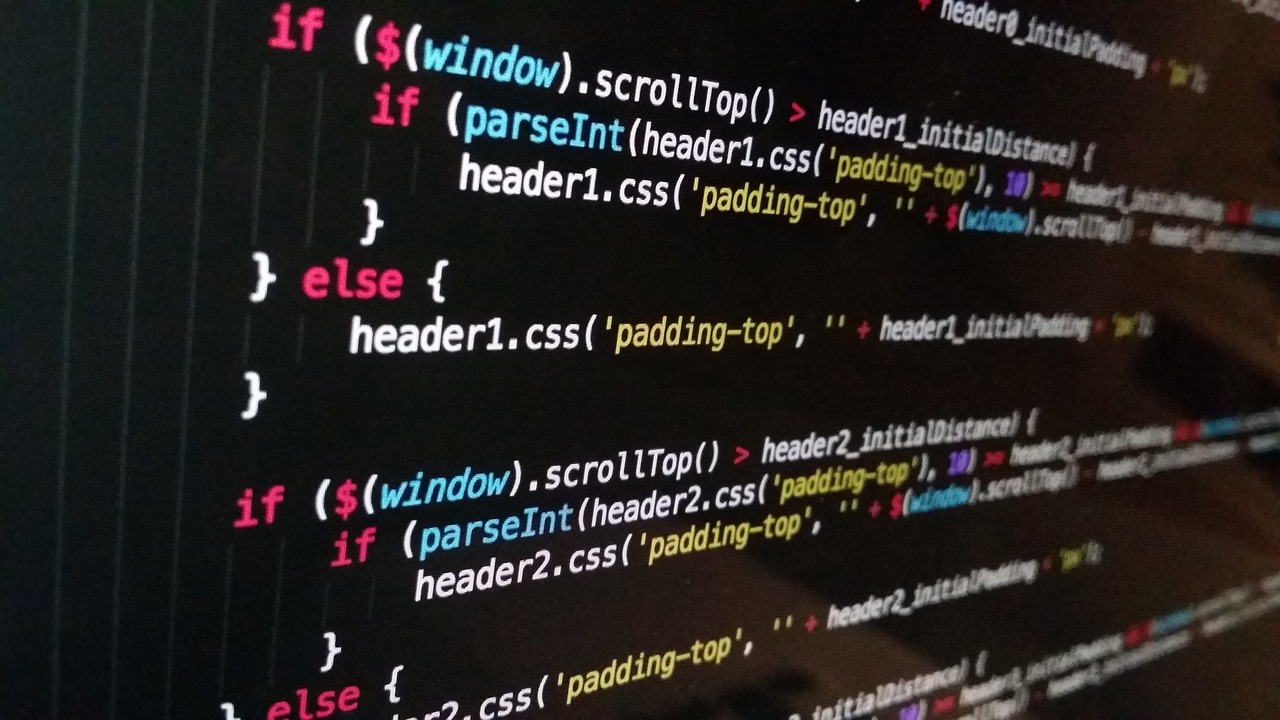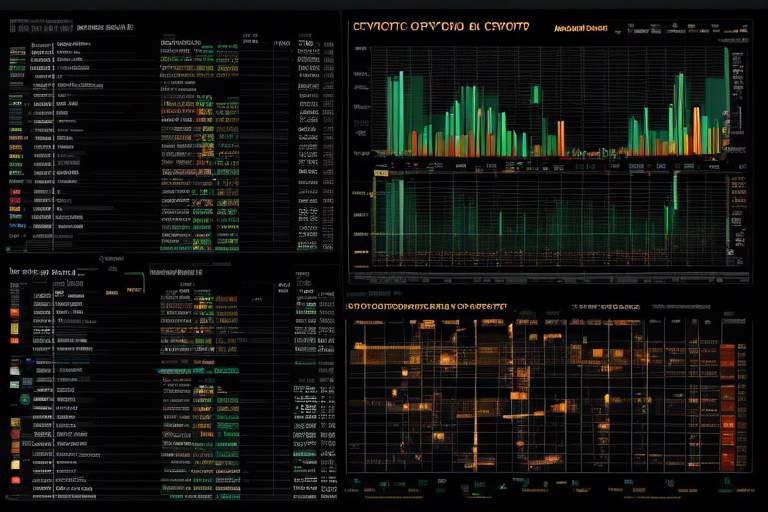Exploring the Benefits of Cross-Chain DeFi Protocols
In the ever-evolving world of finance, cross-chain decentralized finance (DeFi) protocols are emerging as a game-changer, offering a host of advantages that traditional finance simply cannot match. Imagine a world where your assets can flow seamlessly between different blockchain networks, unlocking new opportunities and enhancing your financial experience. This article delves deep into the many benefits of cross-chain DeFi, focusing on how it can enhance liquidity, improve interoperability, and elevate the overall user experience across various blockchain ecosystems.
To truly appreciate the significance of cross-chain DeFi, it's essential to understand the technology behind it. Cross-chain technology enables different blockchain networks to communicate and interact with one another. This is akin to having multiple languages spoken in a room, where everyone can understand each other through a common translator. By allowing the transfer of assets and data across various platforms, cross-chain protocols break down the silos that have historically plagued the blockchain space, paving the way for a more integrated financial ecosystem.
One of the most compelling benefits of cross-chain DeFi protocols is the enhanced liquidity they provide. In traditional finance, liquidity is the lifeblood of markets; it allows assets to be bought and sold quickly without causing significant price changes. Cross-chain DeFi takes this concept to a whole new level by enabling assets to move freely between different networks, creating a vast pool of liquidity that benefits users and traders alike. Imagine being able to trade your assets across multiple platforms without the usual restrictions—this is the reality that cross-chain DeFi aims to create.
Moreover, the interoperability that cross-chain protocols offer is nothing short of revolutionary. In a world where different blockchains often operate in isolation, cross-chain technology acts as a bridge, allowing for seamless transactions and interactions. This interoperability fosters a more cohesive financial ecosystem, where users can engage with a variety of DeFi services without the hassle of switching networks or dealing with complex processes. It's like having a universal remote control for your financial assets—everything you need is at your fingertips.
But it doesn't stop there. The improved user experience provided by cross-chain DeFi protocols is another significant advantage. By simplifying user interactions and offering a unified interface for managing assets across multiple blockchains, these protocols attract more users to the DeFi space. Imagine being able to monitor and manage all your investments from a single dashboard, eliminating the need to juggle multiple wallets and platforms. This streamlined approach not only saves time but also enhances user satisfaction, making DeFi more accessible to everyone.
However, while the benefits are substantial, it's crucial to address the security considerations that come with cross-chain protocols. The interconnected nature of these systems presents unique challenges, including the potential for vulnerabilities during asset transfers. To mitigate these risks, developers are implementing advanced security measures, such as multi-signature wallets and decentralized oracles, to ensure that transactions remain safe and secure. It's a balancing act—leveraging the advantages of cross-chain DeFi while maintaining the integrity of the systems involved.
As we explore the landscape of cross-chain DeFi, it's essential to highlight some successful projects that have made a significant impact in this space. Projects like Thorchain and Polygon have demonstrated how cross-chain capabilities can enhance liquidity and user experience, showcasing innovative strategies that benefit their users. These case studies not only illustrate the potential of cross-chain DeFi but also serve as inspiration for future developments.
Looking ahead, the future of cross-chain DeFi is bright. As the DeFi landscape continues to evolve, we can expect to see more projects embracing cross-chain technology, leading to an even more integrated financial ecosystem. Trends such as the rise of cross-chain bridges and the growing adoption of layer-2 solutions are indicative of the direction in which the industry is headed. The possibilities are exciting, and the potential for innovation is limitless.
However, despite the numerous advantages, cross-chain DeFi faces several challenges that could hinder widespread adoption. Issues such as regulatory uncertainty, technical complexity, and the need for user education are significant hurdles that must be addressed. By tackling these obstacles head-on and developing solutions, the industry can pave the way for a more inclusive and accessible DeFi environment.
In conclusion, cross-chain DeFi protocols represent a transformative shift in the financial landscape. They offer unparalleled benefits in terms of liquidity, interoperability, and user experience, all while presenting unique challenges that require careful navigation. As we move forward, the key takeaway is clear: cross-chain innovations are not just a trend; they are the future of decentralized finance, promising a more connected and efficient financial ecosystem for all.
- What are cross-chain DeFi protocols? Cross-chain DeFi protocols allow different blockchain networks to communicate and interact, facilitating the transfer of assets and data.
- How do cross-chain protocols enhance liquidity? They enable assets to move freely between networks, creating a larger pool of liquidity for users and traders.
- What security measures are in place for cross-chain transactions? Developers use techniques such as multi-signature wallets and decentralized oracles to ensure the security of transactions.
- What is the future of cross-chain DeFi? The future looks promising, with expectations of more integrated financial ecosystems and innovative projects emerging in the space.

Understanding Cross-Chain Technology
Cross-chain technology is like a bridge that connects different islands in the vast ocean of blockchain networks. Imagine each blockchain as its own island, complete with unique resources and communities. Traditionally, these islands have been isolated, making it challenging for users to move assets or data between them. However, with the advent of cross-chain technology, we're witnessing a revolutionary shift that allows these islands to communicate and interact seamlessly.
At its core, cross-chain technology enables the transfer of assets and information across various blockchain ecosystems. This is achieved through a combination of protocols, smart contracts, and interoperability solutions. Think of it as a universal translator that helps different blockchains understand each other's languages. The primary goal is to enhance user experience and facilitate a more integrated financial environment.
There are several key components that make cross-chain functionality possible:
- Atomic Swaps: These are smart contracts that enable direct exchanges of cryptocurrencies between different blockchains without the need for a trusted third party. It's like a direct trade between two friends, ensuring that both parties receive what they agreed upon.
- Wrapped Tokens: By creating tokens that represent assets from one blockchain on another, users can leverage the benefits of multiple networks. For instance, wrapping Bitcoin to use it on the Ethereum network opens up a world of DeFi possibilities.
- Interoperability Protocols: Protocols like Polkadot and Cosmos are designed specifically to facilitate communication between different blockchains. They act as the backbone of cross-chain interactions, ensuring that data flows smoothly.
By enabling these interactions, cross-chain technology not only enhances liquidity but also broadens the scope of decentralized finance (DeFi). Users can now access a plethora of financial services without being limited to a single blockchain. This newfound freedom allows for greater innovation and creativity in the DeFi space, as developers can tap into resources and functionalities from multiple networks.
However, it's essential to recognize that while cross-chain technology brings numerous benefits, it also requires a robust understanding of the underlying principles and potential risks. Just as navigating the ocean requires knowledge of tides and currents, engaging with cross-chain protocols necessitates awareness of security measures and compatibility issues. As we continue to explore this exciting frontier, the importance of education and awareness cannot be overstated.
In summary, cross-chain technology is unlocking a new era of blockchain interactions, enabling users to navigate the financial landscape with ease and efficiency. As we advance further into the world of decentralized finance, the ability to communicate across blockchains will be a critical factor in shaping the future of finance.

Enhanced Liquidity Across Platforms
In the world of decentralized finance (DeFi), liquidity is the lifeblood that keeps the ecosystem thriving. Imagine trying to swim in a pool that’s half-empty; it just doesn’t work, right? Similarly, liquidity in DeFi is about ensuring that there are enough assets available for trading, lending, and borrowing. This is where cross-chain DeFi protocols come into play, acting like a bridge that connects various blockchain networks and allows assets to flow freely between them. With the ability to transfer assets across different platforms, users can tap into a broader market and enjoy enhanced liquidity, which is a game changer in many ways.
One of the most significant advantages of cross-chain DeFi protocols is their ability to unlock liquidity from multiple sources. Traditionally, users were limited to the liquidity available on a single blockchain, which could lead to slippage and poor trading experiences. However, with cross-chain technology, users can access liquidity pools from various blockchains, making it easier to execute trades without significant price impacts. This increased access not only benefits individual traders but also enhances the overall market efficiency.
To illustrate this point, let’s consider a simple example: imagine you’re a trader looking to swap Ethereum (ETH) for Bitcoin (BTC). If you’re confined to a single blockchain, you may find that the available liquidity for your trade is insufficient, leading to unfavorable rates. However, with cross-chain DeFi protocols, you can seamlessly move your assets from Ethereum to a blockchain with higher liquidity for BTC, ensuring that you get the best possible rate for your trade.
Furthermore, enhanced liquidity across platforms encourages more users to participate in DeFi, creating a virtuous cycle. As more traders enter the market, liquidity increases, which in turn attracts even more participants. This influx of users can lead to more innovative financial products and services, further enriching the DeFi landscape. In essence, cross-chain DeFi protocols act as a catalyst, driving liquidity and participation across multiple networks.
Moreover, the ability to tap into various liquidity pools allows for better arbitrage opportunities. Traders can capitalize on price discrepancies across different platforms, buying low on one chain and selling high on another. This not only boosts individual profits but also contributes to overall market efficiency as prices begin to align across different platforms. It’s a win-win situation!
In conclusion, enhanced liquidity across platforms is one of the standout benefits of cross-chain DeFi protocols. By breaking down the barriers between different blockchain ecosystems, these protocols provide users with unprecedented access to liquidity, improved trading experiences, and exciting opportunities for profit. As the DeFi landscape continues to evolve, the role of cross-chain technology in enhancing liquidity will only become more pronounced, making it an essential component of the future financial ecosystem.
- What are cross-chain DeFi protocols? Cross-chain DeFi protocols are systems that enable different blockchain networks to communicate and interact, allowing for the transfer of assets and data seamlessly.
- How do cross-chain protocols enhance liquidity? By allowing assets to move freely between different networks, cross-chain protocols increase the available liquidity for trading, lending, and borrowing.
- What are the benefits of increased liquidity in DeFi? Increased liquidity leads to better trading experiences, reduced slippage, and more attractive arbitrage opportunities for traders.
- Can cross-chain protocols improve market efficiency? Yes, by enabling users to access liquidity from multiple sources, cross-chain protocols help align prices across different platforms, improving overall market efficiency.

Interoperability: A Game Changer
When you think about the world of finance, imagine a vast ocean where different ships (blockchains) sail. Each ship has its own unique design, capabilities, and cargo, but what if they could all dock at the same port? That's where interoperability comes into play, transforming the way we interact with decentralized finance (DeFi). Cross-chain protocols are like bridges connecting these ships, allowing them to share resources, information, and, most importantly, value.
Interoperability in DeFi is about creating a seamless experience for users across various blockchain networks. It eliminates the silos that have traditionally existed, enabling assets to move freely from one chain to another. This is not just a technical feat; it’s a revolution in how we perceive financial transactions. Imagine being able to trade assets from Ethereum on a Binance Smart Chain exchange without the hassle of complex swaps or multiple wallets. This is the promise of cross-chain DeFi protocols, and it’s a game changer.
One of the major benefits of interoperability is the enhancement of liquidity. When different blockchains can communicate, liquidity pools become more robust. Users can tap into a larger pool of assets, which means better prices and reduced slippage. This is particularly important in volatile markets where every second counts. The more interconnected these networks are, the more opportunities traders have to maximize their returns.
Moreover, interoperability fosters innovation. Developers can create applications that leverage the strengths of multiple blockchains, resulting in more sophisticated financial products. For instance, a lending platform could utilize the security of one blockchain while taking advantage of the speed of another. This kind of flexibility encourages creativity and can lead to groundbreaking advancements in DeFi.
However, achieving true interoperability is not without its challenges. Different blockchains have unique consensus mechanisms, governance structures, and transaction speeds. To overcome these hurdles, developers are working on standardized protocols and frameworks that facilitate communication between chains. Projects like Polkadot and Cosmos are paving the way by creating ecosystems where different blockchains can operate together smoothly.
In conclusion, interoperability is more than just a technical requirement; it’s a fundamental shift in how we approach decentralized finance. By breaking down the barriers between blockchains, we can create a more cohesive and efficient financial ecosystem. As we continue to innovate and develop these cross-chain protocols, the potential for growth and user engagement in DeFi is limitless.
- What is interoperability in DeFi?
Interoperability in DeFi refers to the ability of different blockchain networks to communicate and share data and assets seamlessly. - Why is interoperability important?
It enhances liquidity, fosters innovation, and provides users with a unified experience across multiple platforms. - What are some examples of cross-chain protocols?
Projects like Polkadot and Cosmos are notable examples that focus on creating interoperable blockchain ecosystems. - What challenges does interoperability face?
Challenges include varying consensus mechanisms, governance models, and the need for standardized protocols.

Improved User Experience
When it comes to decentralized finance (DeFi), user experience is everything. Imagine walking into a store where every item is in a different language, and the checkout process is a maze. Frustrating, right? That’s how many users feel when navigating traditional DeFi platforms. However, cross-chain DeFi protocols are changing the game by simplifying and enhancing the overall user experience.
One of the key improvements is the introduction of a unified interface. Instead of juggling multiple wallets and platforms, users can manage their assets seamlessly across different blockchains. This means you can trade, lend, or stake assets without the need to switch between various applications. The result? A smoother, more intuitive experience that encourages users to explore the DeFi space further.
Moreover, the integration of cross-chain protocols allows for faster transactions. Users no longer have to deal with the lengthy wait times that can occur when transferring assets between different networks. With cross-chain technology, transactions can be executed almost instantaneously, giving users the satisfaction of knowing their trades are completed quickly. This is particularly beneficial in a market that often moves at lightning speed, where every second counts.
Additionally, the ability to access a broader range of assets enhances the user experience significantly. Cross-chain DeFi opens doors to a plethora of tokens and projects that may not be available on a single blockchain. This increased access means users can diversify their portfolios more effectively, taking advantage of various investment opportunities that were previously out of reach.
Security is also a major concern for users in the DeFi space. Cross-chain protocols are designed with robust security measures to protect users' assets. This includes advanced encryption and multi-signature wallets, which provide an added layer of safety. As users become more confident in the security of their transactions, they are more likely to engage actively with DeFi platforms.
To summarize, the improved user experience offered by cross-chain DeFi protocols is a game changer. By providing a unified interface, faster transactions, broader asset access, and enhanced security, these protocols make the world of DeFi more inviting and user-friendly. As more individuals venture into the decentralized finance arena, it’s clear that cross-chain technology will play a pivotal role in shaping their journey.
- What are cross-chain DeFi protocols? Cross-chain DeFi protocols enable different blockchain networks to communicate, allowing for the seamless transfer of assets and data.
- How do these protocols improve user experience? They offer a unified interface, faster transactions, and access to a wider range of assets, all while enhancing security.
- Are cross-chain protocols secure? Yes, they implement advanced security measures to protect user assets, such as encryption and multi-signature wallets.
- Can I manage multiple cryptocurrencies with cross-chain protocols? Absolutely! Cross-chain DeFi allows users to manage various assets across different blockchain networks from a single platform.

Security Considerations in Cross-Chain Protocols
When diving into the world of cross-chain DeFi protocols, one cannot overlook the crucial aspect of security. While these protocols open up a realm of possibilities for enhanced liquidity and interoperability, they also introduce a unique set of security challenges that must be addressed to ensure user trust and system integrity. Imagine a bustling marketplace where goods are exchanged freely between vendors from different towns; while the trade is exciting, the risk of counterfeit products or dishonest merchants looms large. Similarly, in the digital finance landscape, the potential for vulnerabilities increases as assets traverse various blockchain ecosystems.
One of the primary concerns with cross-chain protocols is the risk of smart contract vulnerabilities. These contracts are the backbone of DeFi, automating transactions and ensuring trustless interactions. However, if a smart contract is poorly coded or exploits are discovered, it can lead to significant financial losses. For instance, in 2021, a high-profile incident involving a cross-chain bridge resulted in millions of dollars being drained due to a flaw in the smart contract. This serves as a stark reminder that while the technology is innovative, it is not infallible.
Another critical aspect of security in cross-chain DeFi is the reliance on oracles. Oracles are third-party services that provide external data to smart contracts, enabling them to execute based on real-world information. However, if these oracles are compromised or manipulated, it could lead to incorrect data being fed into the system, resulting in erroneous transactions. Think of oracles as the weather reporters of the blockchain world; if they misreport the forecast, you might end up carrying an umbrella on a sunny day or, conversely, get drenched without one!
To mitigate these risks, developers and users alike must adopt a multi-faceted approach to security. Here are some key strategies:
- Auditing Smart Contracts: Regular audits by reputable security firms can help identify and rectify vulnerabilities before they are exploited.
- Utilizing Decentralized Oracles: Relying on decentralized oracles can reduce the risk of single points of failure and manipulation.
- Implementing Multi-Signature Wallets: These wallets require multiple approvals for transactions, adding an additional layer of security.
Furthermore, the community plays a vital role in maintaining security. Engaging users in discussions about potential risks and encouraging them to report vulnerabilities can create a more robust ecosystem. Just as a neighborhood watch program fosters safety in a community, a vigilant user base can help safeguard the integrity of cross-chain DeFi protocols.
In conclusion, while cross-chain DeFi protocols present exciting opportunities for innovation and growth, it is essential to approach them with a keen awareness of the security challenges they pose. By prioritizing security measures and fostering a proactive community, we can work towards creating a safer and more reliable DeFi landscape for everyone.

Case Studies of Successful Cross-Chain DeFi Projects
When it comes to cross-chain decentralized finance (DeFi), there are several standout projects that have not only embraced this innovative technology but also demonstrated its immense potential. These projects serve as excellent case studies, showcasing how cross-chain capabilities can revolutionize the financial landscape. Let’s dive into a few of them!
One notable example is Thorchain, a liquidity network that allows users to swap assets between different blockchains without the need for a centralized exchange. Thorchain operates on the principle of liquidity pools, where users can provide liquidity and earn rewards in return. By utilizing cross-chain swaps, Thorchain enables seamless transactions across various cryptocurrencies, significantly enhancing liquidity and user options. This project has gained traction due to its user-friendly interface and robust security measures, making it a favorite among DeFi enthusiasts.
Another impressive project is Ren, which specializes in bringing assets from other blockchains into the Ethereum ecosystem. Ren allows users to mint RenBTC, a Bitcoin-backed token on Ethereum, enabling Bitcoin holders to participate in DeFi activities. This cross-chain functionality not only increases liquidity but also provides Bitcoin users access to a plethora of DeFi services, such as lending and yield farming. Ren’s innovative approach exemplifies how cross-chain technology can bridge the gap between different blockchain ecosystems.
Additionally, we have Cosmos, a network designed to facilitate interoperability between various blockchains. Cosmos employs a unique consensus mechanism and allows developers to create their own blockchains that can easily communicate with one another. This framework enhances the DeFi experience by enabling different protocols to work together, share liquidity, and create a more cohesive financial ecosystem. The success of Cosmos is a testament to the power of cross-chain technology in fostering collaboration within the blockchain space.
Lastly, let’s not forget about Polkadot. This ambitious project aims to create a multi-chain ecosystem where different blockchains can transfer messages and value seamlessly. Polkadot’s architecture allows for the development of parachains, which are individual blockchains that can interact with the main Polkadot chain. This structure enhances scalability and interoperability, making it easier for DeFi projects to thrive. With its innovative approach, Polkadot has positioned itself as a leader in the cross-chain DeFi space.
In summary, these case studies illustrate the transformative potential of cross-chain DeFi protocols. Projects like Thorchain, Ren, Cosmos, and Polkadot not only enhance liquidity and interoperability but also improve user experiences across the blockchain ecosystem. As these projects continue to evolve, they pave the way for a more interconnected and efficient financial landscape.
- What are cross-chain DeFi protocols? Cross-chain DeFi protocols enable different blockchain networks to interact and share assets, enhancing liquidity and user experience.
- Why is interoperability important in DeFi? Interoperability allows various DeFi applications to work together, creating a more cohesive and efficient financial ecosystem.
- How do cross-chain protocols improve liquidity? By allowing assets to move freely between different blockchains, cross-chain protocols increase the availability of liquidity for users and traders.
- What security risks are associated with cross-chain DeFi? Cross-chain protocols can face unique security challenges, including vulnerabilities in smart contracts and the potential for hacks during asset transfers. However, many projects implement robust security measures to mitigate these risks.

The Future of Cross-Chain DeFi
The future of cross-chain decentralized finance (DeFi) is not just a mere extension of current capabilities; it represents a revolutionary shift in how we perceive and utilize financial systems. Imagine a world where your assets can seamlessly flow across different blockchain networks, much like water finding its way through various terrains. This is the vision that cross-chain DeFi aims to bring to life. As we look ahead, several key trends and developments are poised to shape the landscape of cross-chain DeFi.
One of the most exciting prospects is the integration of artificial intelligence (AI) into cross-chain protocols. AI can analyze vast amounts of data across multiple blockchains to optimize trading strategies, predict market movements, and even automate liquidity provisioning. This could lead to a more dynamic and responsive DeFi ecosystem where users can make informed decisions in real-time.
Moreover, as regulatory frameworks continue to evolve, cross-chain DeFi platforms are likely to become more compliant with local laws. This will not only enhance trust among users but also attract institutional investors who have been hesitant to enter the DeFi space due to regulatory uncertainties. The convergence of traditional finance (TradFi) and DeFi will create a more robust financial ecosystem, where cross-chain protocols serve as the bridge between the two worlds.
Another significant trend is the rise of decentralized autonomous organizations (DAOs) that govern cross-chain DeFi projects. These organizations empower users to have a voice in decision-making processes, fostering a sense of community and shared ownership. As DAOs gain traction, we can expect to see more innovative solutions emerging from the collective intelligence of diverse participants.
However, with great potential comes great responsibility. As cross-chain DeFi matures, the focus on security will intensify. Developers will need to implement advanced cryptographic techniques and robust auditing processes to safeguard against vulnerabilities. The ongoing development of interoperability standards will also be crucial in ensuring that different blockchains can communicate securely and efficiently.
In terms of user experience, the future holds promise for creating more intuitive interfaces that cater to both novice and experienced users. Imagine a dashboard where you can manage all your assets across various blockchains with just a few clicks. This simplification will undoubtedly attract a broader audience to DeFi, as barriers to entry are lowered.
Lastly, as we venture into this exciting future, partnerships between cross-chain DeFi projects will become increasingly common. By collaborating, these projects can pool resources, share knowledge, and create comprehensive solutions that benefit users across the board. The synergy created through these partnerships will not only enhance the functionality of individual platforms but also contribute to the overall growth of the DeFi ecosystem.
In summary, the future of cross-chain DeFi is bright and full of possibilities. With advancements in AI, regulatory compliance, community governance, enhanced security measures, user-friendly interfaces, and strategic partnerships, we are on the brink of a new era in finance. As we embrace these changes, the potential for innovation and growth in the cross-chain DeFi space is limitless.
- What are cross-chain DeFi protocols? Cross-chain DeFi protocols are platforms that enable the transfer of assets and data across different blockchain networks, enhancing liquidity and interoperability.
- How do cross-chain protocols enhance user experience? They provide a unified interface for managing assets across multiple blockchains, simplifying user interactions and attracting more participants to DeFi.
- What role will AI play in the future of cross-chain DeFi? AI will optimize trading strategies and automate processes, making the DeFi ecosystem more dynamic and responsive to market changes.
- Are there security risks associated with cross-chain DeFi? Yes, while they offer many benefits, cross-chain protocols also present unique security challenges that require advanced measures to mitigate risks.

Challenges Facing Cross-Chain DeFi Adoption
As the world of decentralized finance (DeFi) continues to expand and evolve, the concept of cross-chain protocols has emerged as a beacon of innovation. However, despite the myriad benefits these protocols offer, several challenges hinder their widespread adoption. Understanding these obstacles is crucial for anyone looking to navigate the complex landscape of cross-chain DeFi.
One of the most significant challenges is the complexity of technology. Cross-chain solutions often involve intricate mechanisms that require users to have a certain level of technical knowledge. For the average user, this can be daunting. Imagine trying to assemble a complex piece of furniture without a manual; that’s how navigating cross-chain protocols can feel for many. The learning curve can deter potential users, limiting the growth of these platforms.
Another critical issue is security concerns. While cross-chain technology aims to enhance interoperability, it also introduces various vulnerabilities. Each blockchain has its own security protocols, and when assets move between chains, they may become exposed to risks such as hacks or exploits. For instance, a flaw in one blockchain could potentially compromise assets on another, leading to significant financial losses. Users need to feel confident that their assets are secure, and any perceived threat can lead to hesitation in adopting these platforms.
Moreover, regulatory uncertainty looms large over the DeFi landscape. Governments and regulatory bodies are still grappling with how to classify and regulate cryptocurrencies and DeFi protocols. This uncertainty can create a chilling effect on innovation, as developers may hesitate to invest time and resources into projects that could face legal challenges down the line. It's like walking a tightrope; one misstep could lead to severe consequences for both developers and users.
Additionally, the issue of liquidity fragmentation arises when multiple blockchains operate independently. Even though cross-chain protocols aim to enhance liquidity, the reality is that many assets remain siloed within their respective ecosystems. This fragmentation can lead to inefficiencies and reduce the overall effectiveness of DeFi protocols. Users might find themselves stuck with assets that cannot easily be transferred or utilized across different platforms, which can be incredibly frustrating.
To tackle these challenges, several strategies can be implemented. For instance, enhancing user education through comprehensive tutorials and resources can help demystify cross-chain technology. Furthermore, developing robust security measures and protocols can instill confidence in users. Finally, industry collaboration can lead to standardized regulations that promote a safer and more inclusive environment for cross-chain DeFi.
In conclusion, while the challenges facing cross-chain DeFi adoption are significant, they are not insurmountable. By addressing these issues head-on, the DeFi community can pave the way for a more integrated and user-friendly financial ecosystem. The future of cross-chain protocols is bright, but it requires collective effort and innovation to realize their full potential.
- What is cross-chain technology?
Cross-chain technology allows different blockchain networks to communicate and interact, enabling the transfer of assets and data between them. - What are the main challenges to cross-chain DeFi adoption?
The main challenges include technological complexity, security concerns, regulatory uncertainty, and liquidity fragmentation. - How can users ensure their assets are secure in cross-chain DeFi?
Users should conduct thorough research on the security measures of the protocols they choose and stay informed about potential vulnerabilities. - What role do regulations play in cross-chain DeFi?
Regulations can impact the development and use of cross-chain protocols, creating an environment that either fosters or stifles innovation.

Conclusion: The Path Forward for Cross-Chain DeFi
In conclusion, cross-chain DeFi protocols represent a transformative shift in the financial landscape, bringing with them a myriad of opportunities that could redefine how we interact with digital assets. As we stand at the crossroads of traditional finance and decentralized finance, the ability to seamlessly transfer assets across various blockchain ecosystems is not just a luxury but a necessity. The potential for enhanced liquidity, improved user experiences, and greater interoperability makes cross-chain technology a cornerstone of the future of finance.
However, it’s essential to recognize that this journey is not without its challenges. While the benefits are substantial, the hurdles of security, regulatory compliance, and user education must be addressed to ensure a smooth transition into this new era. The collaboration between developers, users, and regulatory bodies will play a pivotal role in shaping the future of cross-chain DeFi. As we look ahead, it’s clear that the innovations we see today are merely the tip of the iceberg, and the possibilities are as vast as the blockchain networks themselves.
As we embrace this evolution, it’s crucial for stakeholders to remain informed and engaged. The community must foster an environment of transparency and collaboration, where knowledge is shared, and innovations are celebrated. By doing so, we can collectively pave the way for a more inclusive and efficient financial system that benefits everyone. The path forward for cross-chain DeFi is bright, and those who are willing to adapt and innovate will undoubtedly find themselves at the forefront of this financial revolution.
To wrap things up, let’s consider the key takeaways:
- Cross-chain DeFi protocols enhance liquidity and interoperability.
- Improved user experiences are attracting more participants to the DeFi space.
- Security concerns must be addressed to foster trust in cross-chain transactions.
- Future developments will likely focus on scalability and regulatory compliance.
With the rapid pace of innovation in the DeFi space, it’s an exciting time to be involved. Whether you’re a developer, investor, or simply a curious observer, the advancements in cross-chain technology are sure to impact the financial landscape in profound ways. So, buckle up and get ready for a thrilling ride into the future of finance!
Here are some common questions regarding cross-chain DeFi that might provide further clarity:
- What are cross-chain DeFi protocols? - These are decentralized finance systems that enable the transfer of assets and data across different blockchain networks.
- How do cross-chain protocols enhance liquidity? - By allowing assets to move freely between chains, cross-chain protocols create a larger pool of liquidity, benefiting traders and users alike.
- What security risks are associated with cross-chain DeFi? - Unique security challenges include vulnerabilities in bridging mechanisms and potential exploits in smart contracts, necessitating robust security measures.
- What is the future of cross-chain DeFi? - The future holds promise with advancements in technology, increased user adoption, and potential regulatory frameworks that could enhance the ecosystem.
Frequently Asked Questions
- What are cross-chain DeFi protocols?
Cross-chain DeFi protocols are decentralized finance solutions that enable interoperability between different blockchain networks. They allow users to transfer assets and data seamlessly across various platforms, enhancing liquidity and user experience.
- How do cross-chain protocols enhance liquidity?
By allowing assets to move freely between different blockchain networks, cross-chain protocols create greater liquidity. This means that traders can access a wider range of assets and markets, making it easier to buy, sell, and trade without being limited to a single blockchain.
- Why is interoperability important in DeFi?
Interoperability is crucial because it allows different blockchain systems to work together, creating a more cohesive and efficient financial ecosystem. This connectivity helps users manage their assets across platforms without the hassle of switching between different interfaces or wallets.
- How do cross-chain DeFi protocols improve user experience?
These protocols simplify interactions by providing a unified interface for managing assets across various blockchains. Users can enjoy a seamless experience, reducing the complexity often associated with navigating multiple networks, which ultimately attracts more participants to the DeFi space.
- What security challenges do cross-chain protocols face?
While cross-chain protocols offer numerous benefits, they also introduce unique security challenges, such as vulnerabilities during asset transfers and potential exploits. Developers are constantly working on measures like robust smart contract audits and enhanced encryption to mitigate these risks and ensure secure transactions.
- Can you provide examples of successful cross-chain DeFi projects?
Sure! Projects like Polkadot and Cosmos have made significant strides in cross-chain functionality. They showcase how interoperability can lead to innovative solutions and increased user engagement, demonstrating the potential impact of cross-chain DeFi in the broader financial landscape.
- What does the future hold for cross-chain DeFi?
The future of cross-chain DeFi looks promising, with ongoing developments aimed at enhancing interoperability and user experience. As more users recognize the benefits of these protocols, we can expect to see increased adoption and innovative solutions that further transform the financial ecosystem.
- What challenges does cross-chain DeFi face for widespread adoption?
Despite its advantages, cross-chain DeFi faces challenges such as technical complexities, security concerns, and regulatory hurdles. Addressing these issues will be crucial to achieving widespread adoption and unlocking the full potential of cross-chain technologies.



















